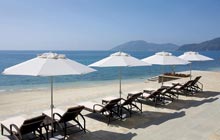
Lying at China’s southern most point, Hainan Island has at various times been a Chinese penal colony, suffered invasion and exploitation by the Japanese, used as a port of free trade, and, in its current incarnation, is an island that China likes to compare with Hawaii. The comparison is not out of place as tourism and a naval base prop up the economies of both places.
 The first Chinese to settle Hainan Island were the Li people. During the Western Han Dynasty (206 BC to 24 AD), many of this Chinese ethnic minority moved from their original home in Guangxi Province to Hainan, displacing the island’s Aboriginal inhabitants.
The first Chinese to settle Hainan Island were the Li people. During the Western Han Dynasty (206 BC to 24 AD), many of this Chinese ethnic minority moved from their original home in Guangxi Province to Hainan, displacing the island’s Aboriginal inhabitants.
Originally referred to as ‘the gates of hell’, Hainan’s most famous exile was Su Dong Po, one of China’s best known literati. He was exiled to Hainan towards the end of the 11th Century for writing poetry criticizing the government. In 1098 the residents of the town that Su Dong Po resided established the Dongpo Academy in memory of him. (This was the second time he had been exiled. He was first exiled in Hangzhou where the famous pork dish Dong Po Rou was named after him. )
 During the 16th and 17th Centuries, the nation’s majority ethnic group, the Han Chinese, began to move to Hainan Island, pushing the Li people into the hilly, southern interior. Eventually the Li people rebelled, forcing the government to send in Miao minority mercenaries. Many of these Miao, originally from Guizhou Province, chose to settle in Hainan and now, these three ethnic groups make up 98% of Hainan’s population.
During the 16th and 17th Centuries, the nation’s majority ethnic group, the Han Chinese, began to move to Hainan Island, pushing the Li people into the hilly, southern interior. Eventually the Li people rebelled, forcing the government to send in Miao minority mercenaries. Many of these Miao, originally from Guizhou Province, chose to settle in Hainan and now, these three ethnic groups make up 98% of Hainan’s population.
Throughout its history, Hainan has been under the command of either Guangxi or Guangdong Provinces. The Second World War saw Japan invade and occupy Hainan for a brief period mining it for iron. At this time, the Chinese Communists and the Li Minority banded together to fight the Japanese, and, in 1950, wrested back control of the island.
In 1988, with Deng Xiao Ping opening the doors to China, the Chinese Government officially gave Hainan independent provincial status. It is from this time that the Hainan of today has developed – a tropical getaway, blessed with white sand beaches and clear blue skies, whose crescent bays are dotted with high-end international resorts. These resorts, together with secondary home real estate developments, have tilted the renown of this once purely agricultural economy away from rubber trees and fruit orchards to an international sun-seekers’ destination where affluent Chinese mix with foreigners in a place where practically everyone is on vacation.